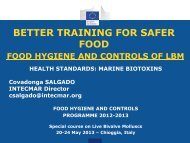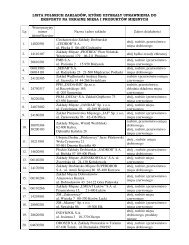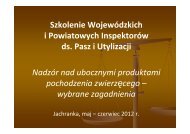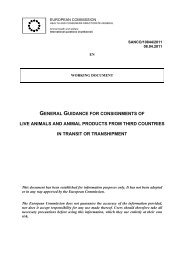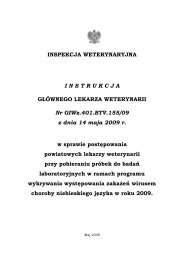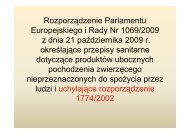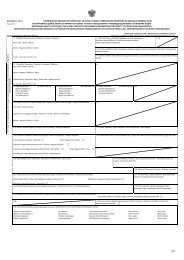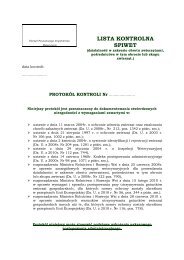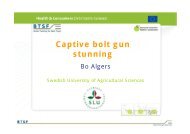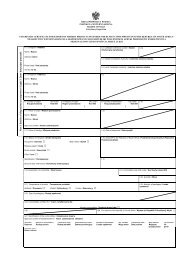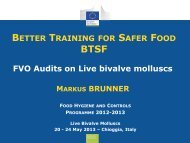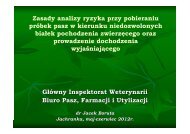Flexibility of the Hygiene Package
Flexibility of the Hygiene Package
Flexibility of the Hygiene Package
Create successful ePaper yourself
Turn your PDF publications into a flip-book with our unique Google optimized e-Paper software.
FLEXIBILITY OF THE HYGIENEPACKAGEFOOD HYGIENE & CONTROLS17-21 June 2013Lisbon, Portugalby Ron Dwinger
flexibilitygoal:‣ maintain European heritage in product diversity‣ reduction <strong>of</strong> administrative burdenssubjects:‣ food safety‣ consumer protectionbe aware:‣ flexibility is not a possibility to give derogation fromEU obligations at establishment level‣ no compromise to <strong>the</strong> goals <strong>of</strong> <strong>the</strong> hygiene legislation
flexibility – legal possibilitiesI derogations/exemptionsII adaptations <strong>of</strong> requirements in some AnnexesIII activities excluded from <strong>the</strong> scope
I - derogations/exemptionsonly Comitologypossibilities for Member States, e.g.- food with traditional characteristics- Trichinella-free holdings- regions with negligible risk <strong>of</strong> Trichinellapossibilities for competent authorities- „competent authority may authorise“- „if competent authority so permits“- „unless <strong>the</strong> competent authority considers…“
national measures for foods withtraditional characteristics 1(some examples)MS product derogationESPLDEcheese, sausages, bakeryprod., olive oil, alcoholicdrinkslist <strong>of</strong> products; register <strong>of</strong>est.sausages, eintöpfe,fruchtaufstriche, milk prod.,etc.infrastructure, equipmentinfrastructure, equipmentinfrastructure, equipment1using Art. 7 (3) <strong>of</strong> Commission Regulation (EC) No 2074/2005
Regulation (EC) No 2074/2005- derogation – granted by Comitology- specified and limited scope <strong>of</strong> derogation- specific products- specific (simplified) notification procedure
II - adaptations• MS decision• defined situations when it is possible- traditional methods <strong>of</strong> production- special geographical constraints (DE)- construction, layout and equipment (CZ)• notification obligatory (<strong>the</strong> <strong>Hygiene</strong>package procedure applies)• described content <strong>of</strong> notifications(description <strong>of</strong> requirements, description <strong>of</strong> foodstuffs andestablishments concerned, explanation <strong>of</strong> reasons, whererelevant – summary <strong>of</strong> <strong>the</strong> hazard analysis)
adaptations• adapt requirements on <strong>of</strong>ficial controls:• continued use <strong>of</strong> traditional methods, at any <strong>of</strong> <strong>the</strong>stages <strong>of</strong> production, processing or distribution <strong>of</strong>food• establishments with low throughput• pilot projects (FR)concerning:• Food Chain Information• presence <strong>of</strong> Competent Authority
national measures taken by MSsome examples• AT and SI: small slaughterhouses• LU: slaughter on farm• FI and SE: reindeer meat• BG: raw-dried and raw-smoked meat products
national measures (AT, SI)- lairage facilities or waiting pens- cleaning & disinfection <strong>of</strong> transport vehicles- slaughter room and cutting room- storage <strong>of</strong> detained meat- minced meat at 4ºC (national market in AT)
national measures (LU)- slaughter on <strong>the</strong> farm- 30 well-equipped farms- slaughter <strong>of</strong> 1200 pigs/year- slaughter <strong>of</strong> 4500 piglets/year- slaughter <strong>of</strong> 250 calves/year
national measures (FI and SE)- local sale (“near food”)- without veterinary supervision (FI)- only in Lapland (Sami people)- sale directly to consumers- 200.000 kg <strong>of</strong> meat/year- national stamp (FI) or 3 villages (SE)
III - activities excluded from <strong>the</strong> scope• MS obligation to adopt national rules• Notification procedure according to Directive98/34/EC• Even if excluded from <strong>the</strong> scope <strong>of</strong> <strong>the</strong> <strong>Hygiene</strong><strong>Package</strong>, Regulations (EC) No 178/2002 andNo 882/2004 apply
activities excluded from <strong>the</strong> scope• public health protected by national law• close relationship between <strong>the</strong> producerand <strong>the</strong> consumerdirect supply <strong>of</strong> small quantities <strong>of</strong>:• primary products by farmers• products collected in <strong>the</strong> wild by individuals• meat <strong>of</strong> poultry and lagomorphs by farmers• wild game or wild game meat by hunters
direct sale <strong>of</strong> primary productsRegulation (EC) No 852/2004• by <strong>the</strong> producer• small quantities• to <strong>the</strong> final consumer or to local retailestablishment directly suppling <strong>the</strong> finalconsumerMS shall establish rules under national law
direct sale <strong>of</strong> o<strong>the</strong>r commoditiesRegulation (EC) No 853/2004• small quantities <strong>of</strong> meat form poultry andlagomorphs• small quantities <strong>of</strong> wild game or wild gamemeat• <strong>the</strong> same conditions as in previous slide• Regulation (EC) No 852/2004 appliesMS shall establish rules under national law
direct supply <strong>of</strong> small quantities <strong>of</strong>poultry meat• MS obligation to adopt national rules• notification procedure according toDirective 98/34/EC• excluded from <strong>the</strong> scope <strong>of</strong> Regulation(EC) No 853/2004• Regulations (EC) No(s) 178/2002,852/2004 and 882/2004 apply
localised, marginal, restrictedactivitiesArticle 1,5,b,ii to Regulation (EC) No 853/2004combination <strong>of</strong> three criteria:• localised – immediate vicinity• marginal – amount/percentage from <strong>the</strong>usual/daily/monthly/yearly production• restricted – certain products or establishmentsonlynotification procedure according to Directive98/34/EC
implementation <strong>of</strong> Article 1,5,b,ii 1MS marginal localised restrictedAT < 5 tons/week; 250tons/yearUK < 1000 LU; 5ton/week;250 ton/yearcounty 25%countyMax 25% (includes nonfood)IE < 1000 kg* 100 km* RTE, mince, < 25%*BE < 800 kg 80 km < 30%SE < 150 tons meat; 100tons milkDK< 3000 kg debonedmeatcountry < 50%region1Regulation (EC) No 853/2004; * still under discussion
national measures• Regulations, ordinances, decrees, administrativeRegulations, guidelines issued by <strong>the</strong> CAs• guidelines issued by pr<strong>of</strong>essional organisations• guidance documents issued by CAs forimplementation by FBOs and for <strong>of</strong>ficial controls
notification procedure- depending on <strong>the</strong> content• Directive No 98/34/EC• <strong>Hygiene</strong> <strong>Package</strong>- information flow between MS and Commission- TRIS system*- database available to public:• information available e.g. MS, draft, standstillperiod, comments and/or detailed opinion* http://ec.europa.eu/enterprise/tris/index_en.htm
• transparencyflexibility - benefits• national measures accepted by <strong>the</strong> Commissionand o<strong>the</strong>r Member States• mutual recognition – single EU market, crossbordertrade• preserve traditional products/production processes
flexibility - difficulties- contradictions• flexibility/harmonisation- misunderstandings• adaptation/derogation- notion <strong>of</strong> „local market“; „small quantities“;„localised, regional and restricted activity“- no notification, drafts changed after notification,unclear measures notified
flexibility - assistance- two documents explaining rules for flexibility (inaddition to <strong>the</strong> guidance documents)- FVO fact-finding missions carried out in <strong>the</strong>Member States- discussion document on small quantities andlocalised, marginal and restricted activities
guidelines for <strong>the</strong> competentauthorities*- legal provisions• derogations/exemptions• adaptations• excluded activities- guidance on understanding andapplicability <strong>of</strong> <strong>the</strong>se provisions- notification procedure applicable* http://ec.europa.eu/food/food/biosafety/hygienelegislation/docs/faq_all_public_en.pdf
guidelines for food businessoperators*• questions and replies• principles- food business operators apply legislation- Member States and/or competent authorities areresponsible to verify, enforce and to use flexibility• examples: approval <strong>of</strong> butcher shops,sale <strong>of</strong> cheese produced at <strong>the</strong> farm* http://ec.europa.eu/food/food/biosafety/hygienelegislation/docs/faq_all_business_en.pdf
implementation <strong>of</strong> flexibilityhow?- food business operators apply legislation- Member States (Competent Authorities)are responsible to provide flexibility t<strong>of</strong>ood business operators (if justified) andCA verify its applicationprocedure- notification to Commission- 3 months period
flexibility for microbiological criteria(Commission Regulation (EC) No 2073/2005) operator can choose frequency and method- based on risk- in <strong>the</strong> context <strong>of</strong> HACCP fixed frequency <strong>of</strong> sampling (carcases, etc.) once weekly fortnightly sampling reduced frequency for small establishments
flexibility for implementation <strong>of</strong>HACCP• Art. 5 <strong>of</strong> Regulation (EC) No 852/2004• all food business operators shall:implement a “permanent procedure basedon <strong>the</strong> HACCP principles”
HACCP for small businessesflexibilityno HACCP, but general hygiene requirements: market stalls, mobile sale vehicles bars, c<strong>of</strong>fee shops small retail shops (grocery shops) storage, transport (pre-packed foods)
HACCP for small businessesflexibility hazard analysis critical limits proportionate monitoring simplified recording (diary, checklist) verification, validation, certification
implementation in BEBusiness to business:> 2 personnel HACCP< 2 personnelno transformation GHPtransformation HACCP lightBusiness to consumer:surface area max 400 m 2 ormax 5 fteHACCP light
implementation in UKan example <strong>of</strong> flexibility‣ for retailers, caterers, take-aways & care homes‣ for Chinese, Indian, Pakistani, Bangladeshi& Sri Lankan cuisines‣ Over 360,000 packs distributedhttp://www.sfbbtraining.co.uk/
it is based upon 4 C’s4C’s are easy categories to remember1. Cross-contamination 3. Chilling2. Cleaning 4. Cooking- general controls for <strong>the</strong> general hazards in akitchen- each <strong>of</strong> <strong>the</strong> 4Cs has Safe Methods- practical methods control specific hazards in <strong>the</strong>business- <strong>the</strong> manager can adapt <strong>the</strong>se methods
what does SFBB pack contain?Safe methods refer to different topics:• important food safety issues• record how it is carried out• record what may have gone wrong• record any preventive action• diary – weekly and 4 weekly reviews• supplier records• cleaning schedule• training records
Safer food,better business<strong>the</strong> pack hasbeentranslatedin Chinese ando<strong>the</strong>rlanguagesIf you would like to order an SFBB packor <strong>the</strong> DVD guidecall Food Standards Agency Publicationson 0845 606 0667or email foodstandards@ecgroup.co.uk
implementation in ATin small slaughterhouses defining small: < 1000 LU/year< 250 tons/year (cutting plant) no CCP control points (temperature) oval health mark
implementation in DK (BE, UK*)in <strong>the</strong> retail (restaurants, shops) food sold to <strong>the</strong> final consumer smiley system (4 grades plus elite) transparent (reports on internet) display clear to customer (fine) started in 2001* “scores on <strong>the</strong> doors”
flexibility – MS requestssome examples*• dangerous (semi-wild) cattle - farmed game• OV presence – farmed game• game handling establishments – plant staff• minced meat (2° C) - allow 4° C• Trichinella examination – laboratory accreditation* see DG(SANCO)/2010-6150 – MR Final
flexibilityFVO recommendations*• introduce flexibility more widely• notify national measures as required• uneven application at local level (give guidelines)• no documentation at local (establishment) levelwhich flexibility measures were applied• simplify notification procedure* see DG(SANCO)/2010-6150 – MR Final
THANK YOU FOR YOURATTENTIONRon DwingerNe<strong>the</strong>rlands Food and Consumer ProductSafety Authority (NVWA)tel.: +31-652527828e-mail: ron.dwinger@vwa.nlAdditional info:http://ec.europa.eu/food/food/biosafety/hygienelegislation/index_en.htmhttp://europa.eu.int/eur-lex/lex/



